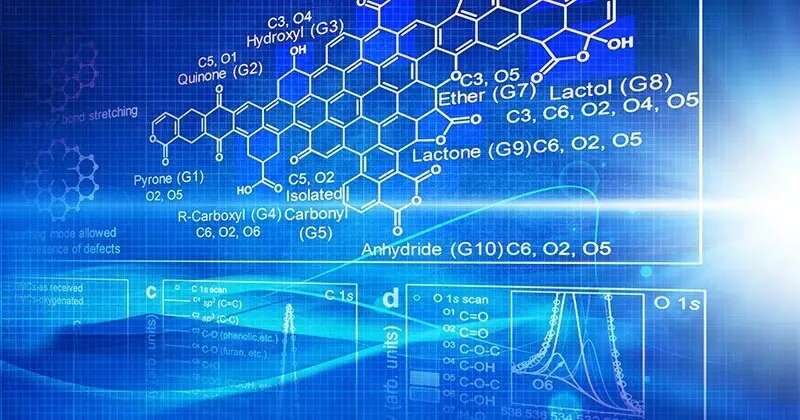This article has been reviewed according to Science X's editorial process and policies. Editors have highlighted the following attributes while ensuring the content's credibility:
fact-checked
peer-reviewed publication
trusted source
proofread
Researchers explore new methods for optimizing carbon-based catalysts

Carbon-based materials have several qualities that make them attractive as catalysts for speeding up chemical reactions. They are low-cost, lightweight and their high surface area provides a good scaffold on which to anchor catalysts, keeping them stable and dispersed far apart, while providing molecules a lot of surface area to work. This makes carbons useful for energy storage and sensors. Over the last 10 years, carbons have been used in electrochemistry to catalyze reactions to make chemicals and fuel cells.
However, in work recently reported in Nature Communications, University of Delaware's Dion Vlachos and researchers in the Catalysis Center for Energy Innovation (CCEI), with collaborators from Brookhaven National Laboratory, made some surprising findings as they were developing techniques to better understand the role oxygen plays in how carbon-based catalysts perform.
According to Vlachos, what they found turned some of what they knew about chemistry upside down.
Not all oxygens are the same
Despite their utility, carbons are not well understood. They are not uniform either. Carbon materials sometimes have oxygen in them, and this oxygen can come in multiple different forms—as an alcohol, aldehyde, ketone or acid. One open question is what the oxygen in these carbon materials does.
So, Vlachos and a team of researchers took carbon molecules and systematically introduced more and more oxygen, then characterized the resulting material using spectroscopic techniques to measure how much and what type of oxygen was present. The researchers did this for a library of about 10 to 15 materials, then performed reactions using the different oxygenated carbons. This allowed them to correlate the carbon material's reactivity with the amount and type of oxygens present using machine learning tools.
The team's work showed a connection between the amount and type of oxygen present and performance, including which oxygens are more active. Counterintuitively, the researchers also found something surprising: long-range effects from aromatic rings far away from a catalyst site can sometimes cause the alcohol groups of the carbon to become more acidic than familiar acidic carbon functional groups found in organic chemistry small acids.
At first, the researchers were surprised, but then they did some calculations and confirmed that the effect was due to the alcohol-based oxygenated carbons in aromatic rings.
"Carbon has aromatic rings," said Vlachos, the Unidel Dan Rich Chair in Energy and director of CCEI, an Energy Frontier Research Center supported by the U.S. Department of Energy. "And the more carbon rings that are added to a material, the greater the chance of creating a regional phenomenon where long-range effects from far away can have a controlling effect on the activity of the catalyst sites."
This is not the case with typical catalysis chemistry, where the effect is very local. For example, bond A affects bond B and that's it.
"The whole chemistry thinking is upside down. This was not expected," he added.
In terms of applications, Vlachos said this means if researchers want to create a more acidic carbon catalyst, they will need to use more alcohol functional groups, in this case, hydroxyls.
The researchers used advanced techniques to validate the mathematical modeling results and characterize what would happen to the oxygen in materials at near-real world conditions, while the chemistry was occurring.
"The University of Delaware team accomplished an impressive feat by using advanced tools and methods to unravel a complicated catalytic system," said Anibal Boscoboinik, a materials scientist with the Center for Functional Nanomaterials, a U.S. Department of Energy (DOE) Office of Science User Facility at DOE's Brookhaven National Laboratory. "We are delighted to have played a part in this significant achievement by conducting measurements using a special kind of spectroscopy at the Center for Functional Nanomaterials."
With this new methodology for determining what each part of the chemistry is doing, the research team can test different techniques for making materials to see what approach has the best effect. For example, are all oxygen molecules equally effective at speeding up catalytic reactions, or are some better than others? Vlachos also is curious whether the oxygen source can be used to disperse metals for reactions. Traditional methods for introducing oxygen into a reaction to make materials are corrosive, so finding greener ways to do this could bring more sustainable processes closer to fruition.
More information: Jiahua Zhou et al, Tuning the reactivity of carbon surfaces with oxygen-containing functional groups, Nature Communications (2023). DOI: 10.1038/s41467-023-37962-3
Journal information: Nature Communications
Provided by University of Delaware





















